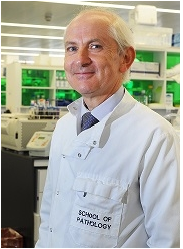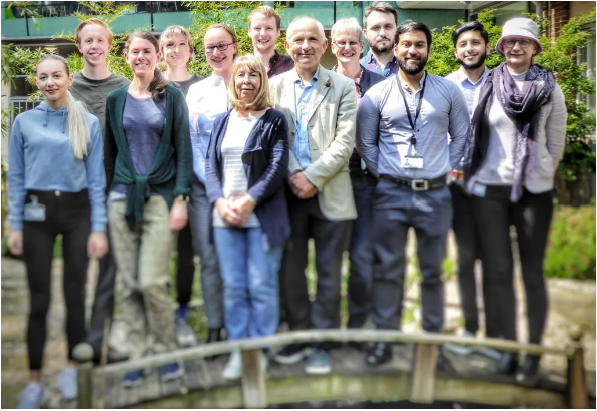When asked if today’s global pandemic is the kind of situation that motivated him to become a virologist, William James replied, “I wish I could say I’d been that starry eyed, but it was really just curiosity that got me started.”
James’s virology lab at University of Oxford’s Sir William Dunn School of Pathology has two distinct research programs: infectious disease and neurodegenerative disease. The group was the first to develop a genetically controllable yet physiologically authentic hIPSC-derived model for the human tissue macrophage.
In layman’s terms, tissue macrophages defend us against infection. Pathogens like HIV, however, can circumvent these sentinels. James’s lab has found a way to model that process in order to better understand it. They collaborate with colleagues around the world everyday and have swiftly mobilized to lead the region’s research response to COVID-19.
 William James
William JamesSince the outbreak, the lab’s neuroscience projects have been put on hold. All infection research has been diverted to the virus. “As an old-school virologist, I’ve been called on to lead Oxford’s core virus containment facility for COVID-19 programs,” James said.
And what does that mean exactly? “It’s a bit complex,” he admitted, “but essentially we’re curating strains of the virus, isolating local strains and providing samples to colleagues who need them to evaluate candidate antiviral drugs and antibody reactions.”
 Sir William Dunn School of Pathology at University of Oxford
Sir William Dunn School of Pathology at University of OxfordThis essential research must be done both in response to and in spite of the virus. James, his 14 researchers and their colleagues must continue to collaborate if they are to learn more about the virus and how to combat it. But what does working together look like when we have to work apart?
“We’re having to review an awful lot of what we do and how we work as a result of this pandemic,” James reflected. About a year ago he reviewed his own work flows when he noticed the lab’s bookshelves were overflowing.
“I thought to myself, there has to be a better way to document our work – the yardage of shelf space we’d dedicated to lab notebook storage was embarrassingly unmanageable. We needed a digital solution.”
James trialed three digital lab notebooks. He now uses LabArchives and so do all his researchers. “It’s great to have an online lab book because all data can be stored there and it’s resilient.” Data never gets lost and nothing can be fabricated down the line – every action is saved, secured and attributed. This transition to digital work, motivated by crowded bookcases, has actually helped prepare the team for the task at hand.
 The entire William James laboratory team.
The entire William James laboratory team.The lab’s weekly meetings are an opportunity to share data and tackle problems together. Now, of course, these meetings are virtual. For the most part though, James and his team are able to continue working as before. No matter where they are, at home or in the lab, every team member can access the data they need and collaborate around that data in LabArchives.
“We believe in sharing our data, collaboration is normal for us,” James said. Despite COVID-19, the lab can continue to work together, share data and consort with colleagues around the world.
From James’s perspective, digital lab notebooks are just a part of the new wave of shared, secure and digitally distributed information. “Being able to share things in a way that is secure and not impacted by location is a big part of finding a way to work effectively but differently during this challenging time. I think we’ll get more and more used to it as a result of this.”
Improved data integrity and contamination risk reduction are other digital benefits. “All COVID-19 data we’re producing is being recorded in LabArchives at the point of generation on a tablet to prevent potentially contaminated paper notebooks from coming in and out of the containment labs,” James said. Effectively, the lab was ready to coordinate a collaborative, secure, well documented and contamination free research response to this global problem.
Despite the dire situation James, someone who understands the virus at its core, can see the silver lining. “COVID-19 has exposed our strengths and weaknesses and it’s amazing to see how researchers all over the world are collaborating right now. We’re all in this together and I don’t think we’ll go back to working the old way, this time is revolutionising.”
Thanks to William James and his team for all of their important work. You can learn more about their COVID-19 research and find their published work here.


















